By Gary Daniels
She missed capture by the Luftwaffe, survived years of dereliction on a Canadian farm and in a Florida field, and roasted for decades in a West Texas hangar. It may not sound like it, but this Yale caught some lucky breaks to become the oldest known North American Aviation-built trainer flying in the world.
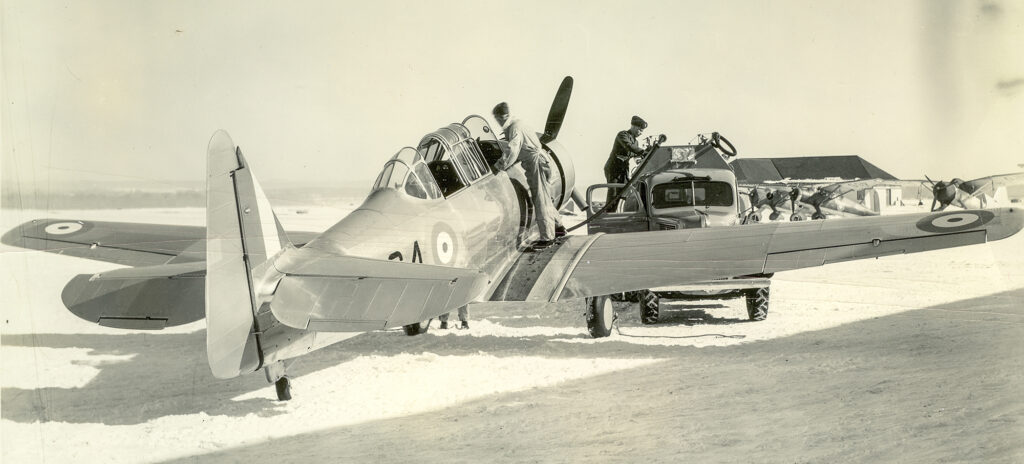
By April 2015, the Cyrier (pronounced seer-ee-a) brothers, Mark and John, had been seeking a treasure for three years on the day they pushed open the creaky doors of the sunbaked hangar in Del Rio, Texas. As the light spilled into the hangar, they saw a North American NA-64 Yale completely intact, although sitting on deflated and dried-out flat tires and covered in a thick, three decade-old layer of dust. For thirty-five years, the Yale had been waiting to be rescued. They knew they had found something unique, and the more they learned, the more they realized just how lucky this Yale had been.
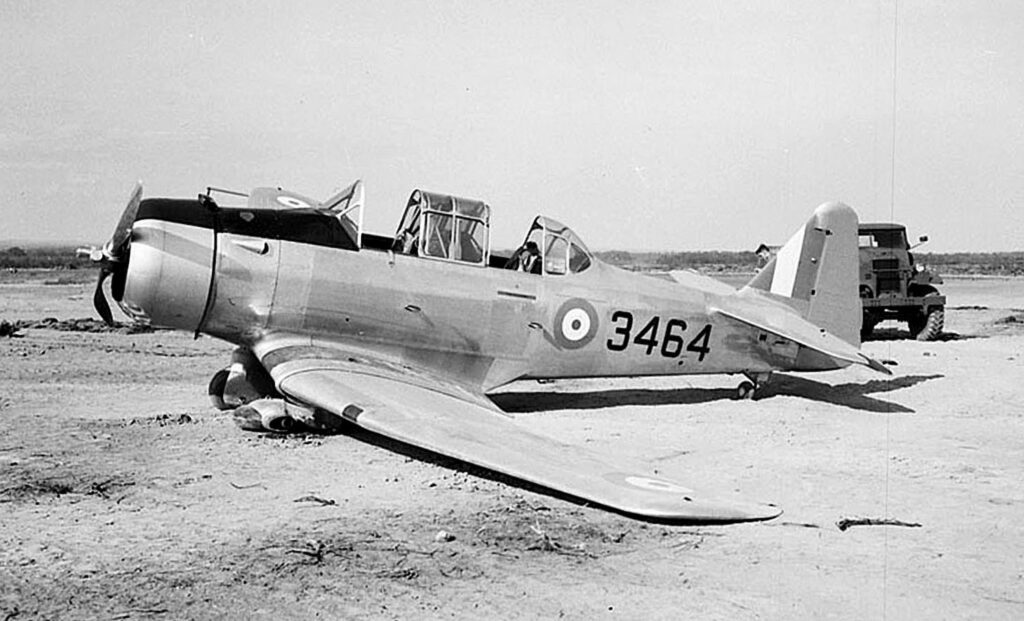
In early 1940, a new war was on low simmer in Europe. This period of WWII is known as the ‘Phony War,’ a relatively quiet eight-month period, from September 1939 to May 1940, when nations were bracing and preparing for what was to come. The allied countries in Europe knew they were in trouble and were looking to the industrial might of the United States to help shore up their walls. At the top of their wish lists were airplanes, and lots of them. Across the pond, America was ramping up for the inevitable. The urgent requests for airplanes had all the aircraft manufacturers in the States humming around the clock.
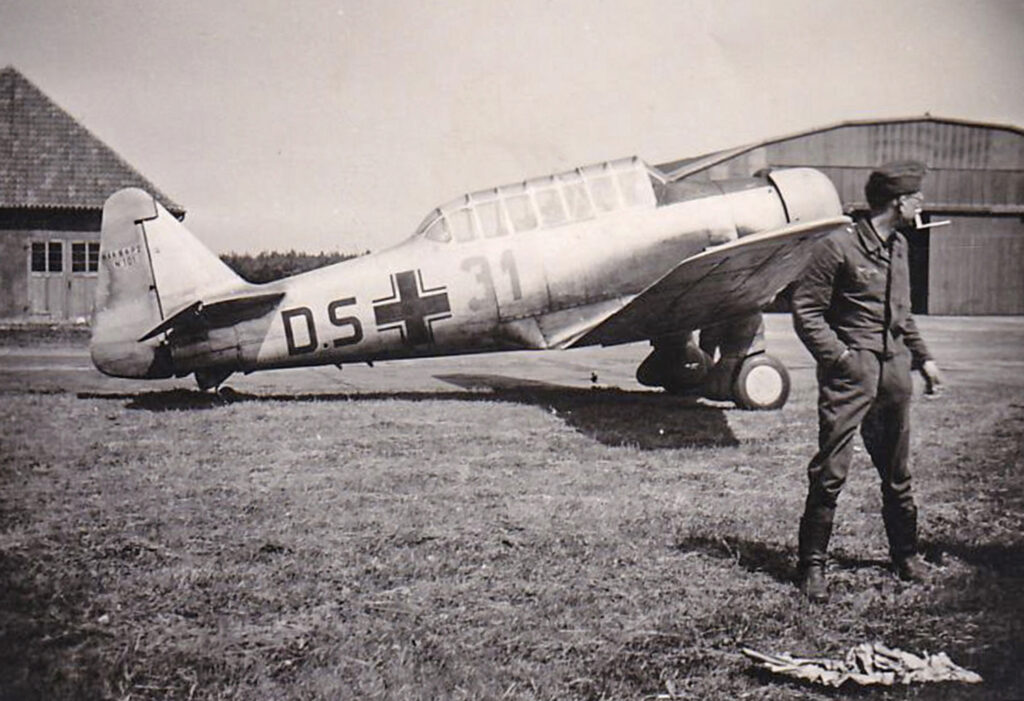
One of these manufacturers was North American Aviation (NAA). In 1940, NAA was enjoying the success of the NA-16, the company’s first trainer, dating to 1935, and its numerous variants. This airplane, with a steel-tubed, fabric-covered fuselage, low wing, single engine, two seats in tandem, and fixed landing gear was the beginning of a very successful line of trainer variants culminating with the fabled AT-6 Texan/SNJ/Harvard. More than 17,000 airframes owe their heritage to the NA-16!
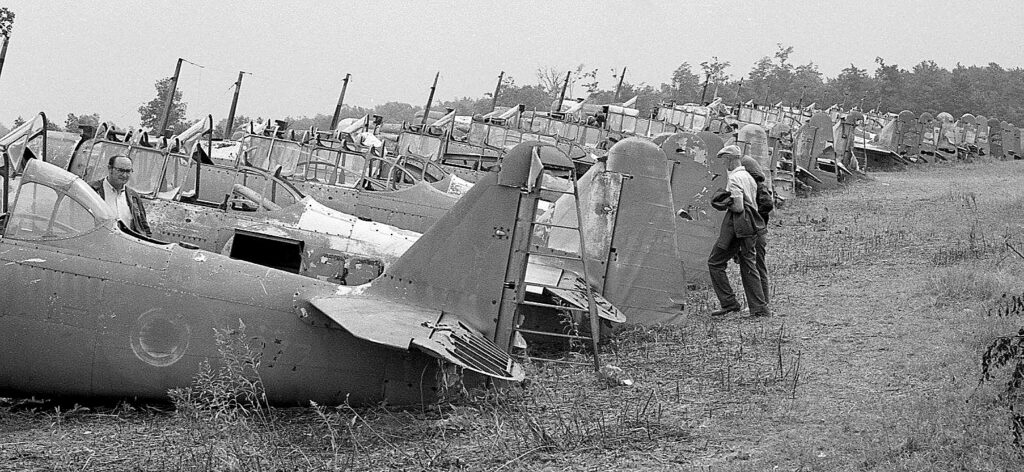
By 1939, France had already received 230 NAA 57-P2 ‘Norths,’ as they were known by the French. The ‘P’ stood for ‘perfectionnement,’ or ‘advanced trainer.’ The NA-57 was powered by a Wright R-975 Whirlwind engine, like the United States Army Air Corp BT-9 variant, but had a Harvard-style canopy. The French wanted more NA-57s and approached NAA for an additional 230, but the NA-57 was deemed outdated and the contract, dated October 10, 1939, was modified to provide the improved NAA 64-P2. The NA-64 had several advancements over the NA-57. Most notable was the longer semi-monocoque aluminum fuselage that replaced the fabric-skinned fuselage of the NA-57. The round rudder of the NA-57 was changed to a new tail design, later used on the AT-6 variant. Because of the tail shape and similar canopy configuration, it is easy to confuse the NA-64 with an AT-6 at first glance. The NA-64 used the same engine as the NA-57 with a two-blade Hamilton Standard propeller.
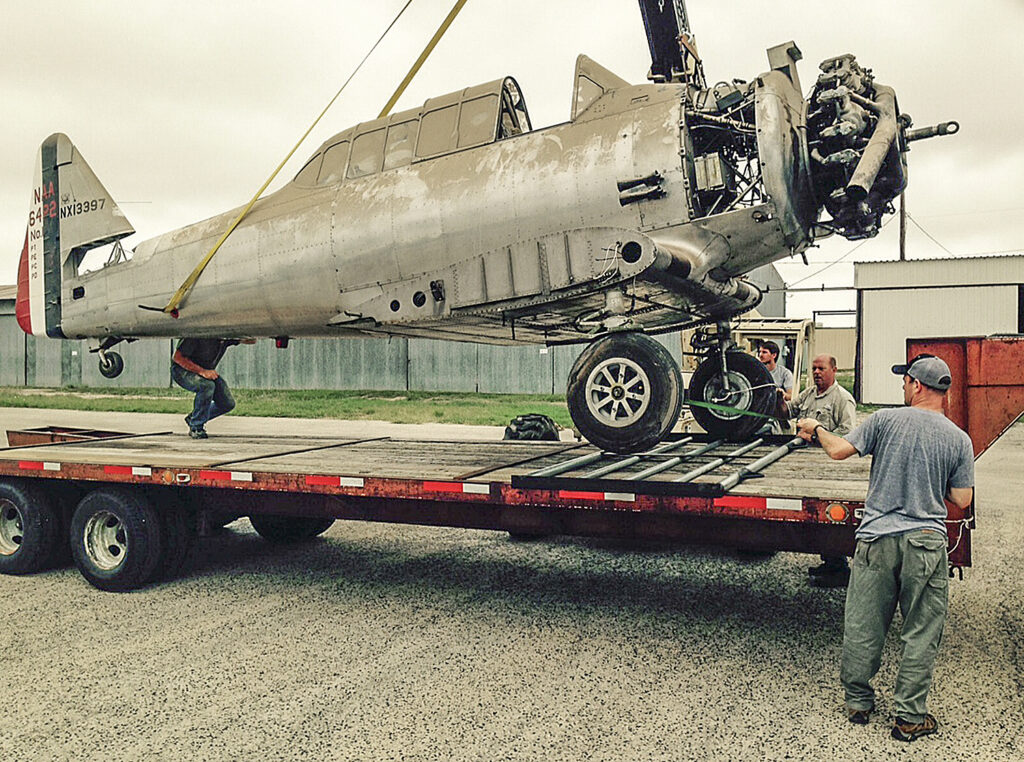
200 NAA 64-P2s were slated for the Armeé de l’Air and 30 for the Aeronavale, when production began in Inglewood, California in late 1939. This is where the subject of this article was born; serial number 64-2033 was the first-built airframe of the contract. 64-2033 rolled off the production line on February 7, 1940, and first flew on February 12th. The aircraft was painted in the minimal French Armeé de l’Air livery: unpainted skin, small French roundels on the wings with the French identification code applied over the blue, white and red stripes on the rudder. Plus, the U.S. civilian experimental registration, NX13397, was added to the fin since this aircraft was used as a civilian aircraft for flight trials.

In the first months of 1940, 111 NA-64s were shipped to France. By May 1940, the low simmer of the Phony War had become an inferno consuming Europe, and France fell to German forces in June of 1940. With the fall of France came the capture of the remaining NA-57s and the newly delivered NA-64s, with some still in their shipping crates. A few managed to escape and flew with the Vichy French Air Force. The captured NA-57s and NA-64s were repainted in various Luftwaffe liveries and used in several roles including pilot training, advanced fighter school, dive-bombing school, reconnaissance, and even two fighter squadrons using the airplanes.
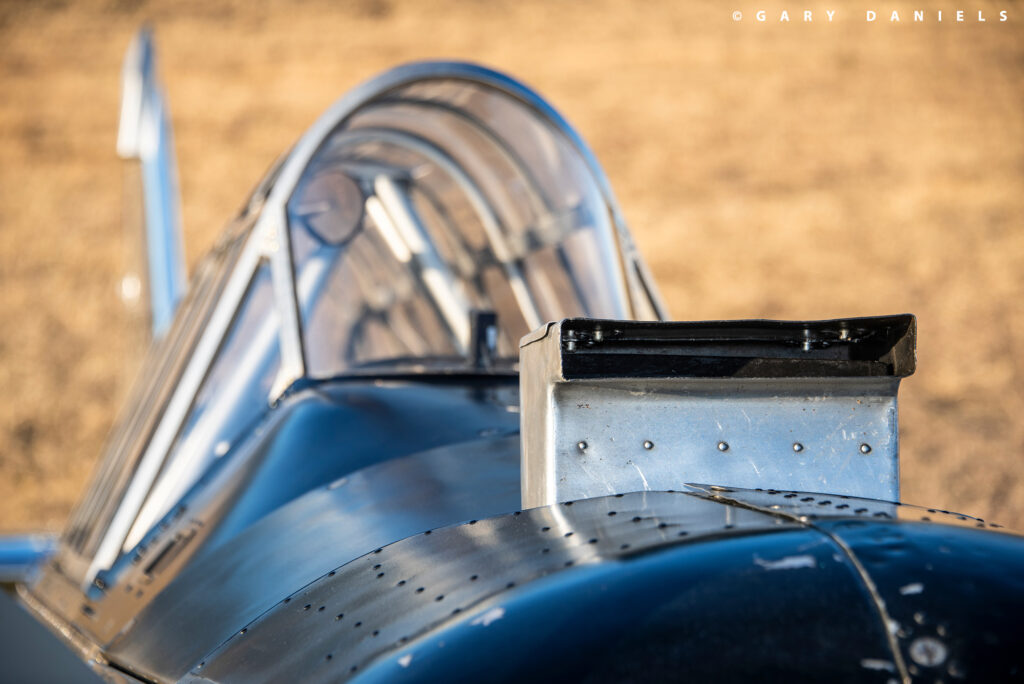
NX13397, however, was not sent to France and was saved from capture by being held back in the California for flight trials, training, and maintenance manual development, the first of several ‘lucky breaks’ to come in the life of this trainer.
With the fall of France, NAA now had 119 undelivered NA-64s on their hands including the prototype, NX13397. In August 1940, NAA sold all the aircraft to the British Purchasing Commission for service in the Royal Canadian Air Force (RCAF) as part of the British Common Air Training Plan. The much-needed trainers were christened the ‘Yale Mk.I’ conforming to the British standard of naming U.S.-built trainers after American educational institutions.
The Bill of Sale for NX13397 is dated August 16, 1940, and shows the aircraft was bought for $10, about $220 in 2024 currency. Records show that NX13397 was ‘taken on strength’ on September 27, 1940, given the RCAF serial number of 3464, and assigned to No. 12 Communications Squadron at RCAF Rockcliffe, Ontario. It served in the squadron until March 1943 when it was transferred to a wireless training squadron.
When the NA-64s arrived in Canada from Inglewood, they were in crates, painted in French markings and configured with French metric instruments and engine control linkages. To convert the Yales, the aircraft were sent to the Canadian railroad rolling stock manufacturer, National Steel Car, for assembly and replacement of various engine controls, including the installation of the Harvard’s throttle, mixture, and pitch quadrant. Cockpit changes included hand painting Imperial units and English translations around the French instruments on the panel. To complete the Canadian conversion, RCAF roundels replaced the small French roundels and large identification numbers were painted on the fuselage. Trainer yellow panels were painted on the top of the wings, tail and on top of the fuselage between the canopy and fin. The vertical French stripes, on the rudder, were painted over with aluminum dope and the RCAF red, white, and blue stripes were painted on the fin.
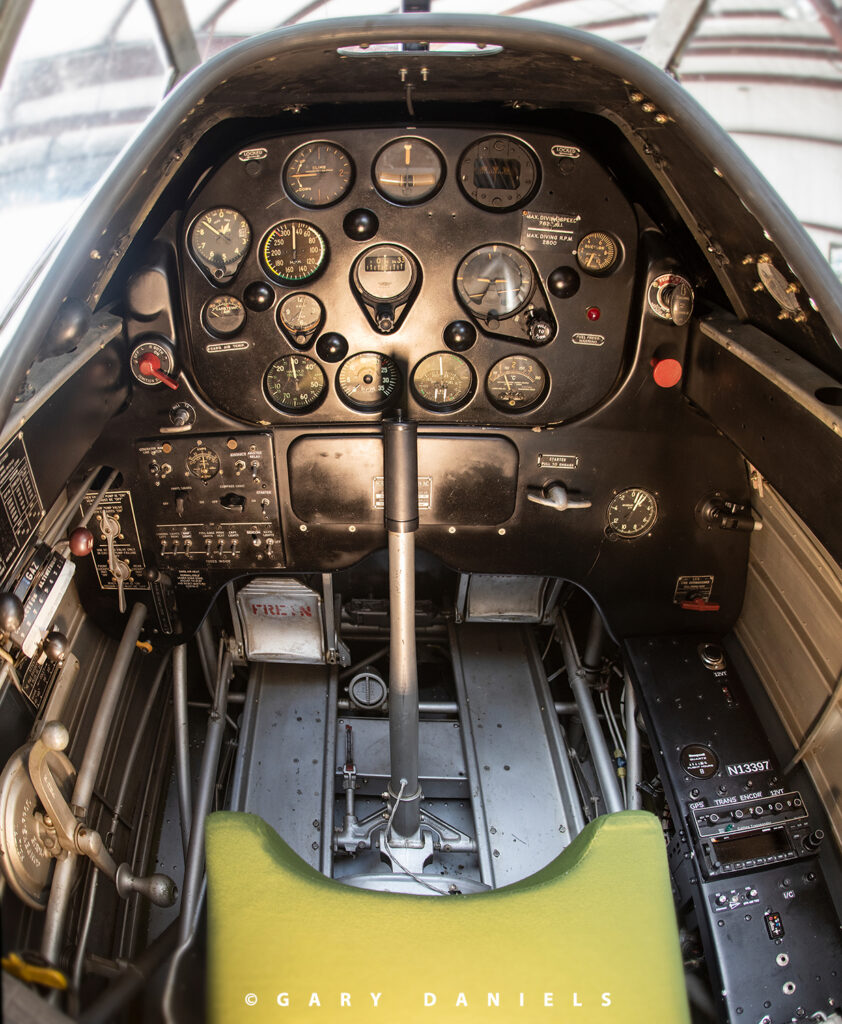
Initially, the Yales filled the need for an intermediate trainer along with the Fleet Fort. Pilot cadets acquired about 56 hours of primary flight training in the de Havilland Tiger Moth, Fleet Finch, or Fairchild Cornell. Then, they completed 50 hours of intermediate flight training in the Yales and Forts before moving on to the Harvards for 50 hours of ‘advanced flying’ to earn their wings. But, by October 1943, the Yales and Forts were removed from the intermediate trainer role. By adding more training hours to the primary and advanced training phases, the intermediate trainer was deemed unnecessary now that the advanced training wings had enough Harvards. Instead, the Yales and Forts were converted to wireless trainers for navigation and communications training.
The wireless trainer conversion involved removing the rear cockpit instrument panel and flying controls. A T1082 transmitter, a R1155 receiver, and a dynamotor to power the equipment were installed. The wireless operator sat in the cramped rear cockpit on his seat-pack parachute. The heavy communication equipment and crew weight in the rear cockpit caused a tail down attitude when trimmed for flight. This required the addition of a large carburetor intake scoop, mounted just behind the cowling, to extend high enough to catch sufficient airflow while flying in the ‘tail down’ flight configuration.
The wireless conversion was the fate of NX13397, eventually transferring to #1 Training Command on March 24, 1944, where it served for the remainder of the war. NX13397 sold for surplus on September 25, 1946, with only 1,570 hours logged. Of the 119 Yales that served in the RCAF, 31 were lost to accidents and operational losses and 88 survived to be sold as surplus in 1946.
And here, NX13397 caught another lucky break. Instead of being chopped up and melted down into aluminum ingots, it was bought from a scrap dealer by an eccentric Canadian farmer who thought he had found a payday. Ernie Simmons was sure the Canadian government would need the Yales again one day, so he bought 39 of them with the intent of selling them back at a profit. Ernie towed the Yales to his farm and sat them in a field side-by-side. There they stayed out in the weather for the next 24 years. Generations of critters snuggled inside the snow-covered airframes during the cold, Canadian winters and scurried about the airframes during the pleasant summers as the aircraft slowly settled into the earth with each passing year. The trainer yellow paint faded and the RCAF roundels etched into the oxidizing aluminum skins.
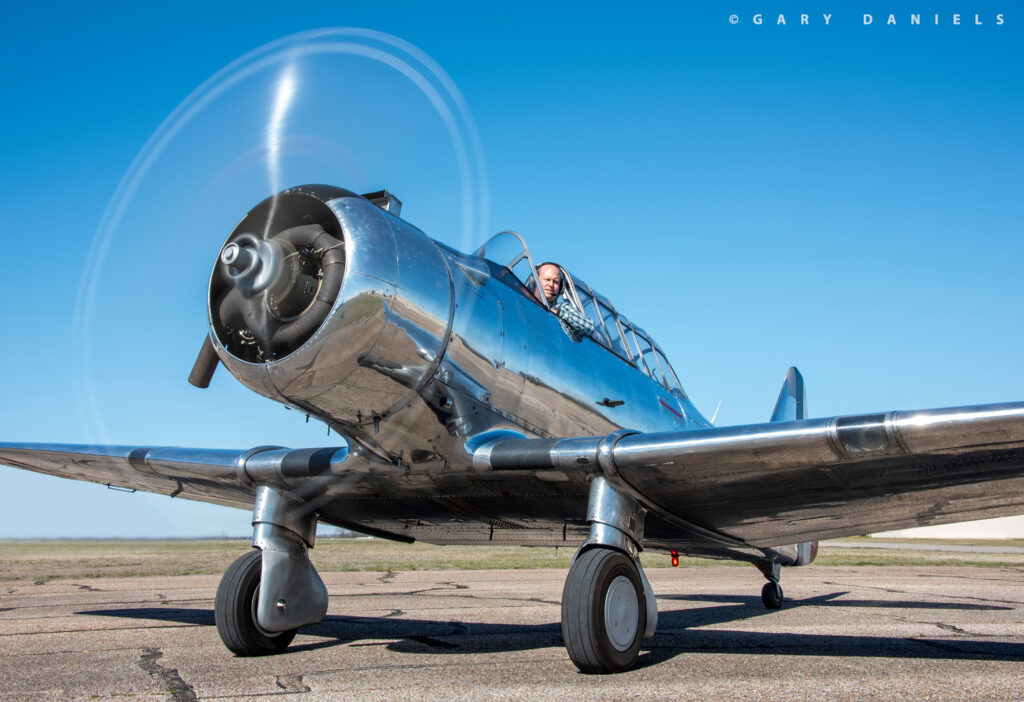
Ernie had a reputation of being an odd and reclusive fellow. He passed in 1970 and did not leave a will. In September 1970, more than 30,000 attended the three-day government auction of his estate. According to a 1988 article about the auction, the Yales were sold at prices ranging from $210 to $530. Various buyers pulled the Yales from the gripping soil of Ernie’s farm. Because of Ernie’s failed plan to make a few bucks, around two dozen Yales survive today.
In 1971, a young skydiving instructor had just taken a ride in a P-51D. Tom Reilly was hooked on warbirds after that flight, and the excitement sparked the start of his amazing aircraft restoration career. It was during this time that, quite by happenstance, Reilly learned of the Simmons’ Yales. Tom eventually tracked down and bought 13 from the various auction buyers and shipped them to Florida. NX13397 was one of these Yales. Tom sold several for a quick profit and began his restoration career by restoring five to flying condition during the early 1970s. But NX13397 was not one of the restored Yales. It sat in a field outside of Orlando, waiting for its next lucky break.
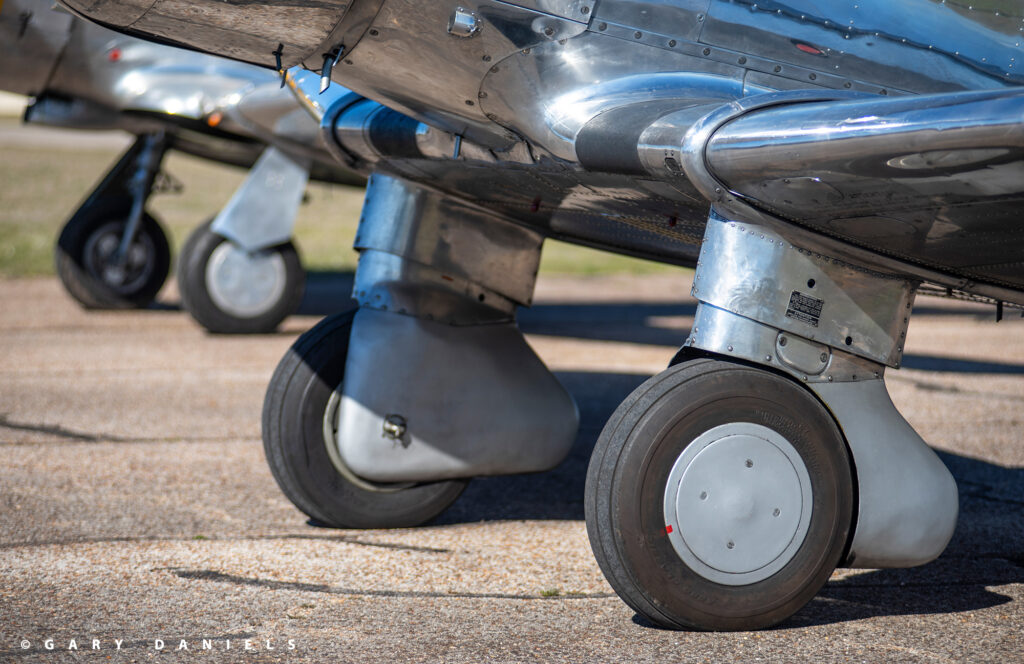
That break came when Tom sold NX13397 to Ray Kirkpatrick. According to Ray’s handwritten expense ledger, he bought the Yale in 1975 for $3,500 out of his retirement fund. Ray was an experienced pilot serving during WWII and flying 727s and 747s for Braniff Airlines. He was also involved in the Confederate Air Force (CAF), as it was known until its name changed to Commemorative Air Force in 2002. He was a flight crew on the B-29 ‘FiFi’ and flew other CAF aircraft all those years ago.
Ray trucked NX13397 to Ft. Worth, Texas, and embarked on an extensive five-year restoration. Ray had a daunting challenge to reverse the damage caused by years of sitting in the weather on a Canadian farm and in a Florida field. But in 1980, NX13397 took to the skies for the first time since standing down from RCAF service in 1946. Ray had also uncovered the significance of this aircraft and debuted the Yale in its original NAA French contract livery. He even flew the newly restored Yale to a CAF airshow in Harlingen, Texas, that same year. During this time, Ray was in discussions with French museums to see if they were interested in adding a Yale to their collections. Luckily, the negotiations never bore fruit, and NX13397 isn’t in a static display somewhere in France today. But it’s unclear why Ray had a change of heart toward the Yale. After a multi-year restoration and just 20 hours logged, Ray parked NX13397 in a hangar in Del Rio, Texas, where he had recently moved, and there it sat for the next 35 years.
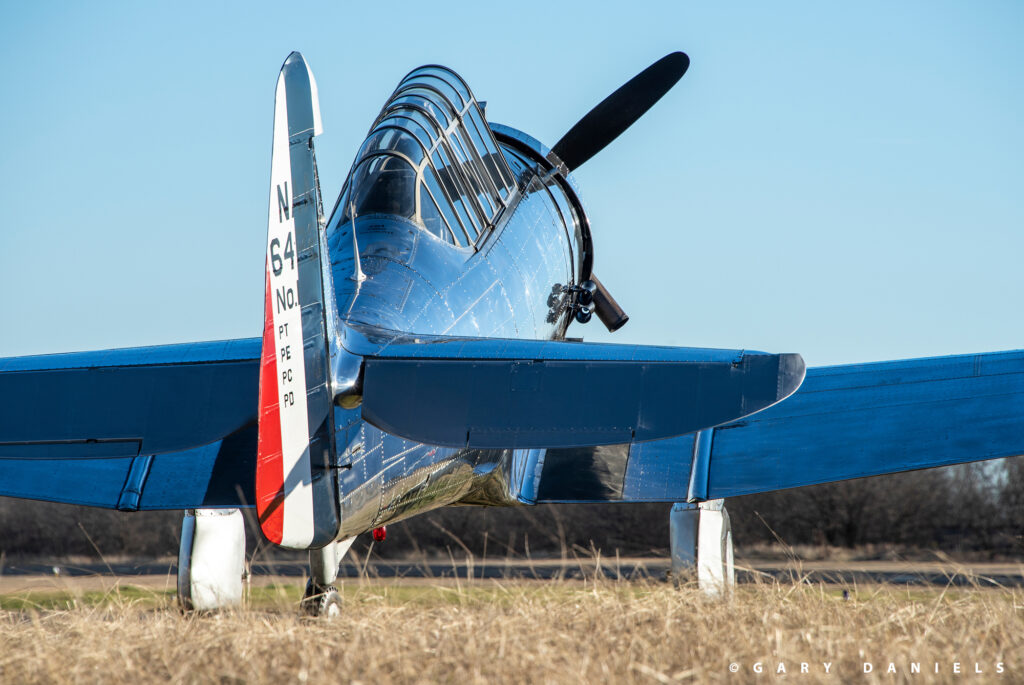
This is where Mark and John enter the story. Both caught the aviation bug early in life. Mark received his airman’s certificate at 16 years old and over the years owned a few aircraft. In 1992, he bought a Ryan L-17, an ex-military Navion that was used in the New Hampshire National Guard for 10 years. “It was a true basket case, missing everything forward of the firewall, the interior, instrument panel, and much more,” he said. “It took eight years to restore. In 2003, it won Best Navion at Oshkosh. It was a great traveling machine. After the Yale showed up in the hangar, I knew the Navion had to go.”
John lives near Austin and enjoys flying his Stearman from his private strip over the tranquil Texas hill country. John was also a Texas State Representative, chairing the state’s General Aviation Caucus. He is the one who stumbled on to the forgotten Yale in the fall of 2012. In a case of ‘water cooler banter,’ an employee of John’s mentioned that his grandfather was a World War II pilot and had a World War II airplane in a hangar in Del Rio that had not flown in years. The employee’s grandfather was Ray Kirkpatrick. The grandson had no idea what the airplane was. John called Mark and told him about the “World War II airplane in a hangar in Del Rio!” Mark chuckled, “We had visions it was a Wildcat, Mustang, Corsair or something like that!”
The grandson connected John to Ray’s daughter, “Aunt Patty,” as they came to know her, and she told him the story of the Yale in Del Rio. Mark recounts: “John went to Del Rio to get an idea about the condition of the plane. It was what you’d expect an airplane to look like after sitting in a hangar in the desert for over 35 years. The plane was straight and complete but would require a restoration to make it flyable.” It wasn’t until the fall of 2013 that Mark and John had the opportunity to meet Ray. He was 92 and in a nursing home. They talked about his life in aviation and how he had discovered that the Yale was the NAA prototype. Ray had acquired valuable information about the Yale and many original war-time documents from NAA from the contract start to its sale to the British. Mark and John were very impressed with Ray, and their interest in the Yale’s future was very much on their minds.
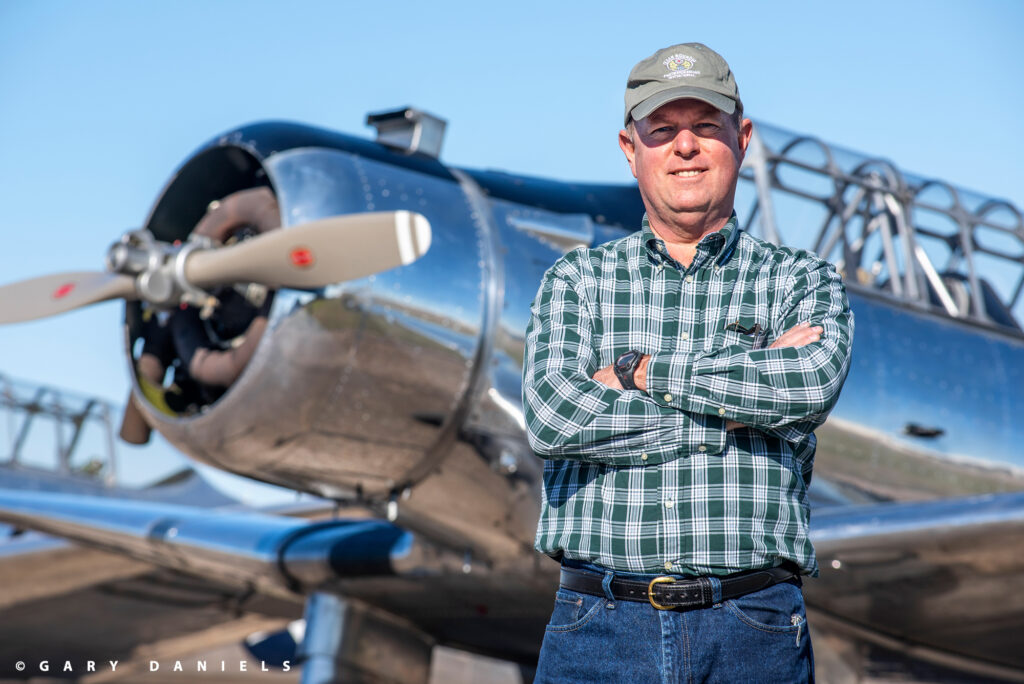
Four months after meeting Ray, he passed away. Mark and John sent condolences to Aunt Patty and expressed their desire to purchase the Yale when the family was ready. Mark recounted: “For nearly three years, John and I would drop her an email with no positive response, so we had pretty well given up. Then, in March of 2015, we received an email saying the family was ready to sell if we were still interested. Aunt Patty said she felt we would be good caretakers of the Yale.” Lady Luck had just smiled on the Yale again.
The sale was final in June 2015, and Mark and John moved the Yale to Mark’s hangar at Hicks Airfield (T67) in Fort Worth, Texas. Mark noted: “The best thing about this airplane is that it had spent the last 35 years in a dry desert hangar. The worst thing about this airplane is that it had spent the last 35 years in a dry desert hangar!” With the years of dirt hosed off, he did a deep dive into the aircraft to determine what to fix, replace or toss, and determined that the overall bones of the airplane were in great shape. However, every system in the plane was heat damaged. A long to-do list was started to repair what Ray had restored 35 years and just 20 flight hours ago.
The greatest concern was how the desert heat had affected the Wright R-975 radial engine. On teardown, it was a welcome surprise that it was in very good condition. Once the engine was apart, everything was cleaned and inspected. Cylinders were honed, new rings were installed, valves seated, exhaust valves replaced with new old surplus, new gaskets, spark plugs, and anything else that needed attention was repaired or replaced. Unlike the engine, most of the engine accessories had been compromised by heat and time. The starter and generator had both survived their 35 years in the hangar, but the other accessories weren’t so lucky. They had to be sent out for overhaul or replacement.
With the engine off of the airframe, the fuel system was reworked and most of the wiring was replaced. The undercarriage was rebuilt and Redline disc brakes from Springer Aerospace were installed. During the restoration, Mark noticed some parts commonality with the T-6 series. The fuel selector, fuel gauges, wobble pump, brake master cylinder, some control rods, wheels, and tires, early T-6 tailwheel and strut, and many other smaller components were shared between the two variants. And the Yale and T-6 share tail group components as well. Lance Aircraft, in Dallas, supplied many of the parts that helped get the Yale airworthy again. Lanny Parcell, owner of Cowtown Aerocrafters, recovered and painted the control surfaces. The Hamilton 2D30 propeller was refurbished by San Antonio Propeller. The rear and front cockpits are true to the original, and the period gauges in both cockpits were overhauled or replaced. Mark also added a GPS and communications radio, transponder, intercom, and ADS-B along with an Angle of Attack (AOA) indicator for increased safety.
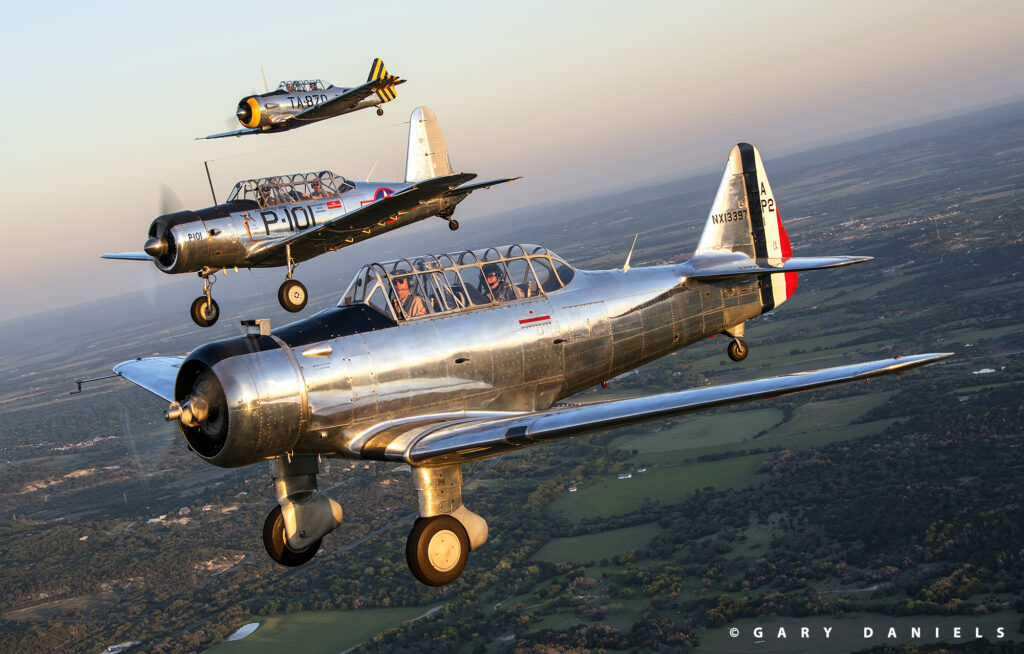
The original aluminum skin of the Yale was in good structural shape considering all it had been through. Dings and scratches can be seen here and there, and if the light reflects off the surface just right, the etched remains of the RCAF roundels and numbers can still be seen. But Mark appreciates the ‘character’ and knows each blemish has a story. After many hours of buffing and polishing, the aluminum skin was brought back to a classic vintage sheen.
Finally, in April 2017, the Yale was ready for its first flight. Scott ‘Gunny’ Perdue of Eagle Flying Museum had the honor of pulling back on the stick on NX13997 and leaving terra firma behind for the first time since 1980. Mark flew back seat, feeling a bit like a proud papa. Scott checked out both John and Mark in the Yale. Mark has since logged more than 160 hours in the Yale. In 2018, he and John flew it to Oshkosh where the Yale looked smart with a constant crowd of admirers packing down the grass around the shiny airplane all week long.
Mark feels honored to be the current caretaker of this very historic airplane. The ‘lucky breaks’ that saved this Yale from extinction are hard to ignore. The fact that it has been airworthy just thirteen years out of the last eight decades and the oldest North American Aviation trainer flying is, frankly, amazing. It’s clear that Mark has a hard time grasping the facts as he contemplates, “This plane first flew in 1940 and accrued about 1500 hours over five years. Then, it sat 24 years on a Canadian farm, four years in a Florida field, restored and flown only 20 hours in 1980, then parked in a desert hangar for 35 years. It has only been airworthy eight years since it was struck off as a war asset in September 1946! I’m trying to remedy this situation by flying it every chance I get!”
Mark knows Lady Luck has smiled on this Yale, and on the Cyrier brothers as well.